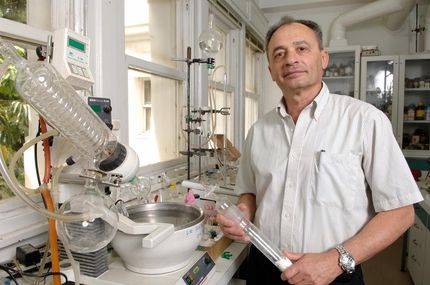How natural oils can be hydrogenated without making unhealthy trans fats
UC Riverside researchers illustrate how controlling shape of heterogeneous catalysts can promote desired chemical reaction
To prolong the shelf life of foods, manufacturers often add hydrogen to natural oils, a process called hydrogenation. But hydrogenation also results in the production of trans fats, which have adverse health effects such as raising bad cholesterol and increasing the risk for coronary heart disorders. Now UC Riverside chemists have designed a catalyst that allows hydrogenated oils to be made while minimizing the production of trans fats.
In their experiments, the researchers, led by Francisco Zaera , a professor of chemistry, used platinum, a common catalyst for these processes. By controlling the shape of the platinum particles, the Zaera group was able to make the catalyst more selective. Zaera's lab found that the platinum catalyst performed most selectively when its particles assumed tetrahedral shapes, with the atoms arranged in a hexagonal honeycomb lattice. Particles with these shapes allow for the preservation of the harmless cis configuration in the hydrogenated fats. Other lattices, the researchers found, favor the production of trans fats.
Platinum catalysts such as those used by the Zaera group are considered heterogeneous because they exist in a different phase (solid) than the reactants (liquid or gas). Compared with homogeneous catalysts, where the catalyst is in the same phase (liquid) as the reactants, heterogeneous catalysts have the advantages of easy preparation, handling, separation from the reaction mixture, reuse, high stability, and low cost.
But their main disadvantage is that, unlike homogeneous catalysts, which tend to be molecular, heterogeneous catalysts must be dispersed as small particles in a high surface-area support in order to optimize their use. This typically results in catalysts with surfaces of ill-defined structures.
The research by Zaera and his colleagues is a breakthrough also because it shows for the first time that it is possible to achieve selectivity with heterogeneous catalysts like platinum by controlling the structure of their surfaces.
"The more control we can exert on how we prepare catalysts, the more we can control the catalytic selectivity of a particular chemical process," Zaera said. "Our work shows that it is possible to make heterogeneous catalysts that afford us more control on selectivity. This opens the door, we hope, for chemists to think about achieving selectivity for other reactions via the design of specific heterogeneous catalysts with specific shapes."
Zaera explained that heterogeneous catalysts tend to be more practical in terms of manipulation, but are harder to control.
Original publication: Nature Materials 2009.
Topics
Organizations
Other news from the department science

Get the chemical industry in your inbox
By submitting this form you agree that LUMITOS AG will send you the newsletter(s) selected above by email. Your data will not be passed on to third parties. Your data will be stored and processed in accordance with our data protection regulations. LUMITOS may contact you by email for the purpose of advertising or market and opinion surveys. You can revoke your consent at any time without giving reasons to LUMITOS AG, Ernst-Augustin-Str. 2, 12489 Berlin, Germany or by e-mail at revoke@lumitos.com with effect for the future. In addition, each email contains a link to unsubscribe from the corresponding newsletter.
Most read news
More news from our other portals
Last viewed contents
MEDIGENE FOCUSES ON CORE COMPETENCIES - Spin off MediGenomix sold to Eurofins Scientific
Avecia Tunes in to 'pPop'TM Gene Expression System
Ace_Industry

Semiconductors for Cool Computers
Study Finds New Properties in Non-Magnetic Materials
Campbell_Brothers

Soft X-ray method promises nanocarrier breakthroughs - Before the huge potential of tiny nanocarriers for highly targeted drug delivery and environmental clean-up can be realized, scientists first need to be able to see them





























































